Campaign Contributions, Contracting, & the Reconstruction of Iraq
An Evaluation of the Defense Industry Since 2001
Following the events of September 11th, America has engaged in the invasion and occupation of Afghanistan and Iraq, while petroleum prices have exploded in response to instability in Iraq and Iran and world energy demand. In the short term, it has been perceived that American military contractors and oil companies have benefited the most in the five years since September 11th. This article will attempt to evaluate the movement of specific defense companies using stock prices as a reflection of growth, especially in comparison to trends in general markets such as the S&P and Dow Jones Industrial.
The first set of graphs presented below represent several defense contractors in diversified services/products (for instance, Boeing provides mainly aircrafts and CACI is a leader in intelligence consulting). It is worth noting in understanding these graphs that the major indexices took significant hits in 2000 and late 2002 to early 2003, and have for the most part underperformed since the bursting of the tech bubble in 2000 within an equally sluggish economy. Apart from providing the weapons, following the succesful invasion, defense contractors were employed to provide security, intelligence, equipment, and other goods and services typically provided by the government itself. Further, in graphs that compare growth, data is calculated with logs, not linearly.

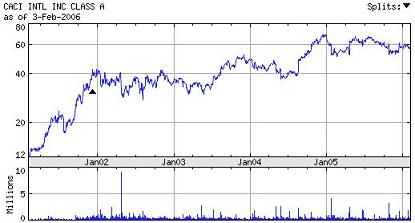
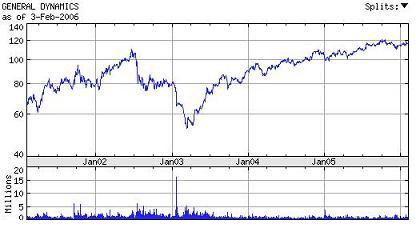
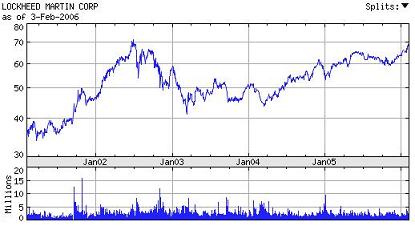
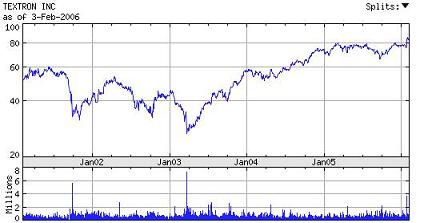
In these graphs, there is above average growth for all companies, especially after the January to March 2003 dip that preceded the invasion of Iraq.
The following graph shows General Dynamics, a fairly average defense contractor, in comparison with the growth rates of the Dow Jones industrial over the past five years:
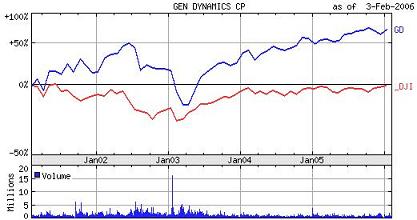
Before the Iraqi war, General Dynamics had growth rates of 15% and 25% in 2001 and 2002 respectively, compared to Dow Jones negative growth of negative 5% and negative 15% in the same years. While growth rates for the Dow Jones have been approximately 0% in 2004 and 2005, General Dynamics grew at 50 percent in 2004 and is approaching 100 percent for 2005.
The following graph illustrates General Dynamics and CACI compared to all three major United States indexices (the Dow Jones Industrial, the NASDAQ, and the S&P 500):
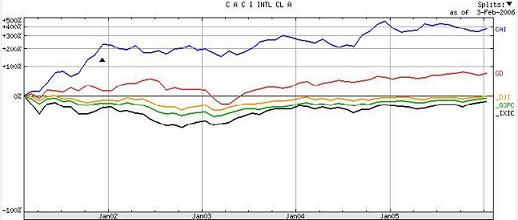
CACI’s growth is shown in context to another defense company in General Dynamics that has also experienced high growth, but General Dynamic’s growth pales in comparison to CACI’s growth, which averages above 250% and has topped out at over 500% the past year.
While the links of other companies to the current administration have been well-documented, I will concentrate on CACI — a mid-sized but increasingly influential company that does intelligence and information consulting, two areas of defense that until recently were conducted within the government itself. Several of CACI’s top management are involved with policy and decision making within the current Bush administration, or have significant ties to the current Pentagon. Directly from CACI’s management page:
Herbert W. Anderson (Outside Director) – In 2001 President George W. Bush appointed Mr. Anderson as a principal member of the President’s National Security Telecommunications Advisory Committee. He currently serves as a member of the Secretary of the Air Force Advisory Group. Mr. Anderson is a former member of the Defense Science Board, the Armed Forces Communications and Electronics Association Board, and as a former subcommittee board member of the Aerospace Industries Association.
Barbara A. McNamara (Outside Director) – served as NSA’s Special U.S. Liaison Officer in London, England until August 2003. She was responsible for representing NSA in its relationships with United Kingdom authorities including the Government Communications Headquarters, the cryptologic organization of the UK. From 1997 to 2000 Ms. McNamara was Deputy Director of NSA. From 1995 to 1997 she was Deputy Director of Operations for NSA. Prior assignments include Executive Director of NSA/Central Security Services (CSS) and NSA/CSS Representative to the DoD.
Arthur L. Money (Outside Director) – served as Assistant Secretary of Defense (ASD) for Command, Control, Communications and Intelligence from 1999 to 2001. He was DoD Chief Information Officer from 1998 to 2001 and Senior Civilian Official, Office of the ASD, from 1998 to 1999. In the Air Force, Mr. Money served as Assistant Secretary for Research Development and Acquisition, and Chief Information Officer.
Gen. Larry D. Welch, USAF (Ret.) (Outside Director) – currently a Fellow at the Institute for Defense Analyses (IDA), a federally chartered research center providing operations, technical, management and information systems analysis for the DoD and other government agencies.
And the most related, almost to a very suspicious point:
Joseph Keith Kellogg – Executive Vice President, Mission Systems Business Group
A former Lieutenant General with the U.S. Army, Mr. Kellogg joined CACI’s top management team in January 2005. Mr. Kellogg most recently was Senior VP of Homeland Security Solutions for Oracle Corporation, having joined the company after a decorated 32-year career in the U.S. Army. He also had taken leave of absence from Oracle to serve the U.S. government as COO of the Coalition Provisional Authority (CPA) in Baghdad, Iraq from November 2003 through March 2004. As a member of the CPA, Mr. Kellogg served on the staff of Administrator L. Paul Bremer. He played a key role in the effort to rebuild Iraq and bridge the link between security and critical infrastructure. As a result of his service, the Secretary of Defense awarded Kellogg the Department of Defense Medal for Distinguished Public Service, the highest defense award that civilians may receive.
In essence, Mr. Kellogg was the Chief Operating Officer of the provisional government in Iraq, giving him a significant amount of influence in spending decisions in security and intelligence. After elections were held and the CPA made way for elected officials, Mr. Kellogg went directly into the private sector with a firm competing for federal contracts that he used to approve.
Though spending has been criticized, the recently released budget from the White House increases defense spending by five percent while decreasing other programs by 14.5 billion dollars. This forecasts sustained growth in the defense sector.
President Bush plans to propose a $2.7 trillion budget tomorrow that would shrink most parts of the government unrelated to the nation’s security while slowing spending on Medicare by $36 billion during the next five years, according to White House documents. The spending plan Bush is to recommend to Congress will call for the elimination or reduction of 141 programs — for a savings of $14.5 billion…
In contrast, the president plans to recommend for the Department of Homeland Security an increase of at least 5 percent from this year’s funding of $30.8 billion, not counting emergency spending to recover from last year’s hurricanes in the Gulf Coast region, congressional aides said. Similarly, the budget will contain an increase of nearly 5 percent in the Pentagon’s funding for next year, defense officials said. The $439.3 billion includes $84.2 billion for weapons systems, an 8 percent increase in weapons spending.
In conclusion, corporate donors from the defense industry have seen a high return to their campaign contributions, and corporations such as CACI with clear links to past and present Pentagon and White House officials have seen exponential growth. These have not been proportional returns, as the top contributors have not in all instances been the companies to be awarded the most contracts. The Defense industry in general has enjoyed unprecedented growth during the Bush administration, and much appears to be linked to former Republicans and Defense officials involved in both the Pentagon and private companies.
Sources
All graphs were done within Yahoo Finance.
The United States General Account Office — Report to Congressional Committees on 2003 Contracts in Iraq. http://www.gao.gov/new.items/d04605.pdf
The Top 50 Defense Contractors: http://www.fas.org/man/company/top.htm
Defense Industry Corporations by Political Contributions http://www.publicintegrity.org/wow/bio.aspx?act=pro
President Bush’s proposed budget for 2006-2007. http://www.washingtonpost.com/wp-dyn/content/article/2006/02/04/AR2006020401179.html










[…] Gee, REALLY? No one ever thought about this before. Ever. […]
digital tinglysning hobro…
Campaign Contributions, Contracting,…
ejendomsmæglere asnæs…
Campaign Contributions, Contracting,…